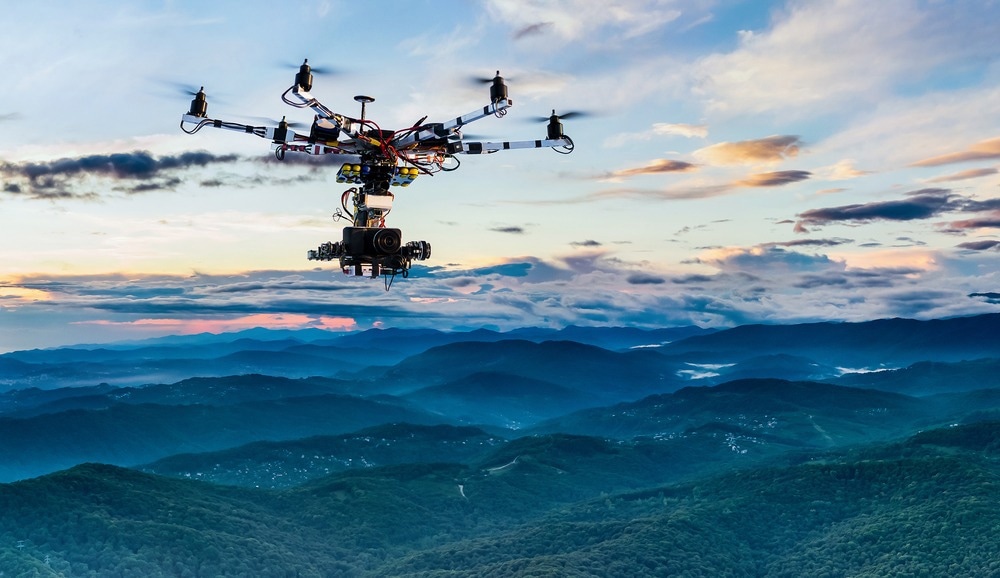Drones have become technologies of choice in multiple fields in recent years, conferring several benefits compared to conventional aerial technologies. Learn about the increasing role of drones in aerial cinematography.

Image Credit: Burben/Shutterstock.com
Introduction to Drones in Entertainment
Entertainment and film are multi-billion dollar global industries, worth around $234.9 billion in 2020, according to some observers. Since its inception, the entertainment industry has embraced emerging and innovative technologies to tell stories on film in new and ever-more sophisticated ways.
Drones are an emerging technology in the entertainment field, allowing filmmakers to shoot aerial scenes at a fraction of the cost and time required when using conventional technologies such as helicopters. Furthermore, drones are opening up new creative opportunities in moviemaking that were not previously possible with established technologies.
Role of Drones in Aerial Cinematography
Drones are increasingly playing a central role in aerial cinematography, replacing established but expensive and complex equipment such as cranes, helicopters, and chase cars. Chase cars alone can typically cost anywhere between $5,000 and $10,000 per day. Helicopters can cost even more: up to $50,000 for a 10-hour day.
Drones can be used to provide aerial cinematography for a range of productions, from movies to sporting events, news programs, and much more, bringing many benefits to the toolkit of the director or reporter.
Advantages of Using Drones for Filmmaking
Like any industry, cost is a key factor in entertainment, with cost overruns potentially sinking production. As mentioned above, drones are a significantly cheaper option than conventional alternatives such as helicopters and cranes.
Labor costs can also be drastically reduced: a helicopter, for instance, requires a camera crew and a pilot. On the other hand, drones only require the use of one trained operator.
Drones are also highly versatile and dynamic, able to maneuver in tighter spaces, providing directors with completely new capabilities and filming perspectives. They are able to get much closer to the action than alternatives, further enhancing the dynamic possibilities of aerial cinematography.
Drones have played a key role in the increasing popularity of dynamic tracking shots within the moviemaking industry, creating immersive experiences for the audience. They can be used to follow actors through elaborate scenes and provide unparalleled benefits for high-speed chase scenes.
Drones also improve safety by removing film crew from potentially dangerous situations and have real-time monitoring benefits for filmmakers. In short, drones significantly benefit creativity at a much lower cost and with improved safety than previously possible in the entertainment industry.
Techniques and Challenges of Aerial Cinematography with Drones
Several different types of shots can be performed using drones. These include bird’s-eye view, tracking, reveal, orbit, crane, and tilt reveal shots. These are possible due to the unparalleled maneuverability of commercial drones such as quadcopter devices. Specially designed cameras also make these shots possible.
Tracking shots, for example, are possible due to a drone’s excellent ability to follow an object, either close up or at a distance. The flexibility of drones, for instance, allows them to mimic expensive and cumbersome cranes in the crane shot. The drone moving forward or back while the camera tilts makes the tilt reveal possible.

Image Credit: Alex Yuzhakov/Shutterstock.com
Although drones possess significant benefits for aerial cinematography, there are some challenges that need to be overcome to successfully film a movie using these technologies.
Firstly, weather conditions can severely hinder the use of drones, much like in any other industry. Equipment can be damaged by rain, footage can become destabilized by windy conditions, and fog can impact captured footage.
Secondly, battery life can be a severe limitation for drone use in aerial cinematography due to limited flight times, necessitating careful planning. Furthermore, legal concerns such as airspace restrictions in urban areas can impact the use of drones. If operated incorrectly, drones can cause safety issues for the crew and the public.
Despite the rapid development of drones in recent years, some technical limitations with them still affect their use in aerial cinematography, such as stabilization issues and shooting in low light. Finally, drone footage may require a lot of time in post-production to ensure the best quality shot.
Future Trends and Innovations in Drone-Based Entertainment
Some intriguing trends are emerging in drone-based entertainment that will no doubt push the field to new heights in the coming years.
Artificial intelligence is a highly disruptive technology, and new generations of drones are utilizing it. AI-enabled drones possess enhanced dynamic capabilities for filmmaking, with the possibility of predicting optimal shots, amongst other benefits.
Virtual reality and augmented reality are also on the rise in the entertainment industry, creating immersive experiences for audiences. Drones can play a key role in this emerging frontier in filmmaking and entertainment. Collaborative swarms of drones coordinated by AI could revolutionize action scenes, as well.
New generations of drones also possess enhanced capabilities, such as better stabilization and longer battery life, improving their utility for aerial cinematography. Furthermore, this technology is much more accessible than current options for indie filmmakers, democratizing the movie industry.
Finally, drones are a much more environmentally friendly option than equipment such as helicopters, which will help the entertainment industry meet its sustainability goals and reduce its carbon footprint. It can be said that drones are fast becoming a transformative technology in cinematography and the entertainment industry.
References and Further Reading
DroneU (2023) Drone Cinematography: How to Create Cinematic Masterpieces [online] thedroneu.com. Available at: https://www.thedroneu.com/blog/drone-cinematography-guide/
Martijn (2023) Drones in Filmmaking: The New Age of Cinematography [online] drone-operator.com. Available at: https://www.drone-operator.com/drones-in-filmmaking-the-new-age-of-cinematography
United Rotorcraft (2020) How Drones are Changing the Entertainment Industry [online] unitedrotorcraft.com. Available at: https://www.unitedrotorcraft.com/newsroom/how-drones-are-changing-the-entertainment-industry/
Disclaimer: The views expressed here are those of the author expressed in their private capacity and do not necessarily represent the views of AZoM.com Limited T/A AZoNetwork the owner and operator of this website. This disclaimer forms part of the Terms and conditions of use of this website.